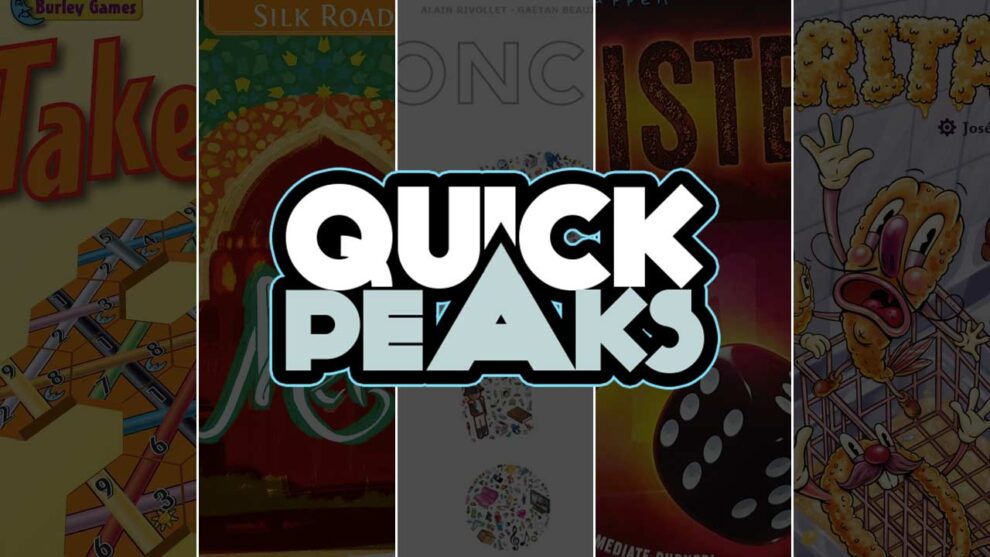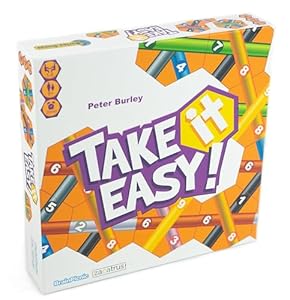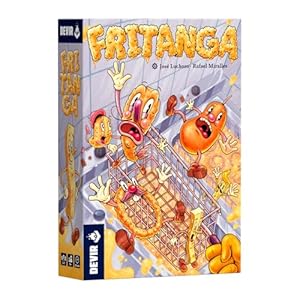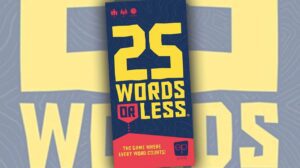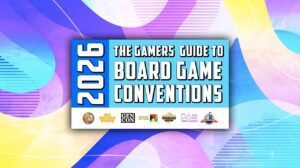Take It Easy! – Justin Bell
Take It Easy!—which could have easily been called “Bingo: The Tile-Layer” due to its central signal-caller requirement as players all place the same tile onto their board at the same time, albeit in a specific location of the player’s choosing—is one of the oldest games I’ve played in years. Take It Easy! is 43 years old as of this posting date and is still available for purchase on the web.
That’s crazy, right? Turns are simple because this game comes from a simpler time. One player shuffles all of their tri-numbered tiles face-down, then reveals them one at a time to all players, with each player then required to place that tile anywhere on their small mat. Scoring is tied to the connections made by each time placement during the game; all of your fours will score, as long as only fours make up their connection from one end of your board to the other, for example.
That means end-game scoring can get a bit mathy. “Could someone hand me a calculator?” said one player, after remembering that all mobile phones have a calc built in. So, figuring out scores is one thing; the other issue I had was a weird one. Because all players could place their tiles wherever they want, what’s stopping a player from side-eyeing their very experienced neighbor to see how they are placing each tile? No one in my play was cheating, but there’s also nothing stopping your “tryhard”, win-at-all-costs uncle from doing something similar. Take It Easy! was fun, even if I don’t expect to try it again.
Ease of entry
★★★★★ – No sweat
Would I play it again?
★★★☆☆ – Wouldn’t suggest it, but would happily play it
Read more articles from Justin Bell.
Merv: The Heart of the Silk Road – Andy Matthews
I’ve had Merv: The Heart of the Silk Road on my radar ever since we reviewed it back in 2022. The game is gorgeous, with the clean lines and vibrant colors that artist Ian O’Toole is known for. And the designer pedigree doesn’t hurt either: Fabio Lopiano is known for many excellent games such as Ragusa, Autobahn, 3 Ring Circus, and his most recent release Shackleton Base: A Journey to the Moon.
Merv (for brevity’s sake) is set in the distant past and pits players as merchants in the desert city of Merv. The goal of the game may be points, but there are many interconnected systems you must learn and manage in order to earn even a single one. Do you visit the palace in order to earn favor, the mosque to show your piety, the library to gain knowledge, or the caravansary to acquire spices? And those aren’t even all of them. For someone who is only recently into heavier games like Merv, it’s a lot to keep in your head.
That said, once you’ve cataloged the things you need to do, you can transition from a walk to a trot or run in just a few rounds. Even though there were 4 players at the table, there were several different avenues towards victory. Two players focused on the caravansary and acquiring spices for the set collection aspect, another player went heavy on the marketplace and completing contracts, and I zoomed up the mosque track and comboed that with palace courtiers for a decisive victory. Merv is certainly a game which requires players to pay attention to the others at the table lest you allow your opponent to gain the win like I did.
Ease of entry?:
★★★☆☆ – There were a few questions
Would I play it again?:
★★★★☆ – Would like to play it again
Read more articles from Andy Matthews.
Concept – David McMillan
Concept is a word-guessing game that feels like a cross between Pictionary and Codenames. There is a clue giver who is given a card containing several words or phrases. They choose one of these and then, using only a bunch of cubes, plastic standees, and a game board dotted with iconography, they try their best to get the concept across to the other players so that they can successfully guess it to earn points—without saying a single word.
I’ve seen people playing this before, but had never had an opportunity to try it for myself. Last night, I finally got my chance, and I had a blast. Concept is a very clever game that does an amazing job of making you feel very clever. There’s nothing quite as satisfying as signifying that the phrase you’re trying to get across is a concept and then using a bunch of cubes to cover every aspect of a picture of a foot except for the heel and having one of the players shout out “Achilles’ Heel!” and scoring a ton of points. And that’s just half the fun. The other half comes from listening to other people describe the way that THEY would have done it.
Concept doesn’t just foster creativity. It fosters understanding. It fosters kinship. And, more importantly, it fosters fun.
Read our review of Concept.
Ease of entry:
★★★★★ – No sweat
Would I play it again?
★★★★★ – Will definitely play it again
Read more articles from David McMillan.
Knister – K. David Ladage
I have played a lot of games over the years. Some have been great, others fall flat. Knister is that second type of game. It falls flat because I just do not get it. Roll dice. Put the sums into a 5×5 grid. Look at each column, row, and diagonal and score for pairs, triplets, four-of-a-kind, five-of-a-kind, and straights (with or without using a 7). Done.
When I was introduced to the game, the rules took less than two minutes to explain. And we were off. As I played, my brain kept looking for some strategic level of thinking that could go into a game like this. But after a few dozen plays, I am convinced it is either not there, or I am not one to find it. In the end, it feels like Yahtzee, only less.
Ease of entry:
★★★★★ – No sweat
Would I play it again?
★☆☆☆☆ – Would play again but will cry about it
Read more articles from K. David Ladage.
Fritanga – Justin Bell
Fritanga (Devir, 2025) is a card game that asks players to take on the role of fried foods hoping to avoid death by fryer. That should have led to solid gold reviews from the players who joined me for two plays (one at three players, the other at seven players). Unfortunately, Fritanga suffers from a strange problem: it’s incredibly difficult to teach because the game features iconography so dense that it is screaming for player aids. Sadly, the manual is the only player aid included. This meant that I had to pass the rulebook to a player on almost every turn.
But Fritanga had such promise! In a free-for-all or in a teams format, players can play as a corn dog, a french fry, an onion ring, or something else fried that would normally just be tossed in a fryer. Turns are simple—play any number of cards from hand, then move one or two spaces across a grid of cards that all feature hot oil on one side and various game effects on the other. Moving around the grid could lead to an instant death. This level of chaos generally works—sometimes, you can switch places with another food item, or play an Exploding Kittens-style “nope!” card to negate a game effect, or you can re-add cards to the grid to create more spaces to move across during a turn.
The problem isn’t the chaos…the problem is understanding what’s possible. Even during my second game, I didn’t have all the icons down, so when adding a card to my hand, I almost always needed the rulebook. Players do have a chance to avoid death by playing a “Fritos” card to stay in the game, but usually, the second death is the final one and that eliminates a player from the game in the last-food-standing format. That’s not terrible in a game that might take 20 minutes, but it is still a negative for people looking to avoid player elimination format games. There’s also an all-versus-one format that we tried at seven players, called “Everyone Against the Chef”, where one player tries to murder all other players by the end of the eighth turn. Fritanga isn’t bad, but it badly needs an aid or words on the cards to explain card effects. As it is, it is a very challenging party filler despite its promising theme.
Ease of entry?
★★☆☆☆ – Not an easy onboard
Would I play it again?
★★★☆☆ – Wouldn’t suggest it, but would happily play it
Read more articles from Justin Bell.


